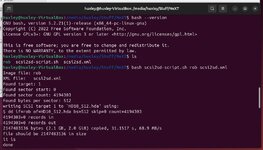I just wanted to pop into this old thread and say a big loud THANK YOU to
@dburr for making and sharing this awesome tool! I recently swapped out a failing SCSI2SD device for a BlueSCSI in my NeXT Computer (aka Cube) but had no way to recover the multiple partitions of apps and tools that were on the SCSI2SD's MicroSD card.
Unfortunately, the only modern Mac I have access to currently is heavily locked down (it's a work computer with some intense MDM software installed), so doing the conversion there was a no-go. Given this, I set up an Ubuntu virtual machine in VirtualBox on my PC, so I'd at least have an unrestricted Linux environment to use for this project.
Because the SCSI2SD's card doesn't have any volumes or partitions that a modern computer can make sense of (it's literally a bunch of raw data dumped onto the card), I could not get it working with this script in my VM. I did manage to make a raw "dd" type image file of the MicroSD card, which was a big step in the right direction.
Using this tool was an ordeal for a non-Linux person like me, but after much trial-and-error and many confused Google searches, I got it to work and it elegantly and swiftly created separate, correctly-named HDA images from the 'raw data' on the MicroSD card. Amazing!
Here's a Pro Tip for anyone doing this who (like me) isn't a Linux wizard: if you're going to do this from Ubuntu like I did, you can't just invoke the script - you have to literally type the word "bash" before the script name, image name, and XML file. Also, you might find that your life is easier if you remove any spaces from the filenames of the script, your image, and the XML file. Here's a screenshot of the output once I got it working - I hope this helps someone else down the road!
 (note that "rob" is the name of the MicroSD card image I created with the "dd" tool - it's named after Rob Blessin, the awesome NeXT vendor who sold me the original SCSI2SD setup loaded with software)
(note that "rob" is the name of the MicroSD card image I created with the "dd" tool - it's named after Rob Blessin, the awesome NeXT vendor who sold me the original SCSI2SD setup loaded with software)

